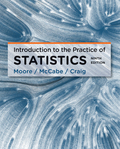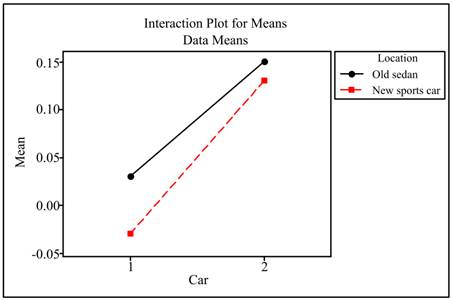
Concept explainers
(a)
To graph: The plot for means.
(a)
Explanation of Solution
Graph: To obtain the interaction plot, use Minitab. Follow the steps below:
Step 1: Insert the data into Minitab worksheet.
Step 2: Go to Stat > ANOVA > Interaction plot.
Step 3: Select “Means” in the column for Responses and select “Location and Car” in the column for Factors.
Step 4: Click OK.
The obtained interaction plot is obtained as shown below:

Interpretation: The interaction plot represents that there is a little interaction between two Chromium means. There may be an interaction for the larger values.
(b)
To find: The pooled standard deviation.
(b)
Answer to Problem 35E
Solution: The required pooled standard deviation is 0.12777.
Explanation of Solution
Calculation: The pooled standard deviation is calculated by using the formula as shown below:
The pooled standard deviation is obtained as follows:
Interpretation: The pooling of standard deviation can be applied here because the data values satisfies the condition that the value of maximum standard deviation is less than the twice of the minimum standard deviation value, i.e.,
(c)
Section 1:
The contrast to compare the mean for new with old car.
(c)
Section 1:
Answer to Problem 35E
Solution: The contrast of compared groups is as follows:
Explanation of Solution
Section 2:
The contrast to compare the means for new car while driving in city.
Section 2:
Answer to Problem 35E
Solution: The contrast of compared groups is as follows:
Explanation of Solution
Section 3:
The contrast to compare the mean for highway with city while driving an old car.
Section 3:
Answer to Problem 35E
Solution: The contrast of compared groups is as follows:
Explanation of Solution
(d)
The benefit of repeated measurements.
(d)
Answer to Problem 35E
Solution: The repeated measure of study reduces the within group variation.
Explanation of Solution
Want to see more full solutions like this?
Chapter 13 Solutions
Introduction to the Practice of Statistics
- Should you be confident in applying your regression equation to estimate the heart rate of a python at 35°C? Why or why not?arrow_forwardGiven your fitted regression line, what would be the residual for snake #5 (10 C)?arrow_forwardCalculate the 95% confidence interval around your estimate of r using Fisher’s z-transformation. In your final answer, make sure to back-transform to the original units.arrow_forward
- BUSINESS DISCUSSarrow_forwardA researcher wishes to estimate, with 90% confidence, the population proportion of adults who support labeling legislation for genetically modified organisms (GMOs). Her estimate must be accurate within 4% of the true proportion. (a) No preliminary estimate is available. Find the minimum sample size needed. (b) Find the minimum sample size needed, using a prior study that found that 65% of the respondents said they support labeling legislation for GMOs. (c) Compare the results from parts (a) and (b). ... (a) What is the minimum sample size needed assuming that no prior information is available? n = (Round up to the nearest whole number as needed.)arrow_forwardThe table available below shows the costs per mile (in cents) for a sample of automobiles. At a = 0.05, can you conclude that at least one mean cost per mile is different from the others? Click on the icon to view the data table. Let Hss, HMS, HLS, Hsuv and Hмy represent the mean costs per mile for small sedans, medium sedans, large sedans, SUV 4WDs, and minivans respectively. What are the hypotheses for this test? OA. Ho: Not all the means are equal. Ha Hss HMS HLS HSUV HMV B. Ho Hss HMS HLS HSUV = μMV Ha: Hss *HMS *HLS*HSUV * HMV C. Ho Hss HMS HLS HSUV =μMV = = H: Not all the means are equal. D. Ho Hss HMS HLS HSUV HMV Ha Hss HMS HLS =HSUV = HMVarrow_forward
 MATLAB: An Introduction with ApplicationsStatisticsISBN:9781119256830Author:Amos GilatPublisher:John Wiley & Sons Inc
MATLAB: An Introduction with ApplicationsStatisticsISBN:9781119256830Author:Amos GilatPublisher:John Wiley & Sons Inc Probability and Statistics for Engineering and th...StatisticsISBN:9781305251809Author:Jay L. DevorePublisher:Cengage Learning
Probability and Statistics for Engineering and th...StatisticsISBN:9781305251809Author:Jay L. DevorePublisher:Cengage Learning Statistics for The Behavioral Sciences (MindTap C...StatisticsISBN:9781305504912Author:Frederick J Gravetter, Larry B. WallnauPublisher:Cengage Learning
Statistics for The Behavioral Sciences (MindTap C...StatisticsISBN:9781305504912Author:Frederick J Gravetter, Larry B. WallnauPublisher:Cengage Learning Elementary Statistics: Picturing the World (7th E...StatisticsISBN:9780134683416Author:Ron Larson, Betsy FarberPublisher:PEARSON
Elementary Statistics: Picturing the World (7th E...StatisticsISBN:9780134683416Author:Ron Larson, Betsy FarberPublisher:PEARSON The Basic Practice of StatisticsStatisticsISBN:9781319042578Author:David S. Moore, William I. Notz, Michael A. FlignerPublisher:W. H. Freeman
The Basic Practice of StatisticsStatisticsISBN:9781319042578Author:David S. Moore, William I. Notz, Michael A. FlignerPublisher:W. H. Freeman Introduction to the Practice of StatisticsStatisticsISBN:9781319013387Author:David S. Moore, George P. McCabe, Bruce A. CraigPublisher:W. H. Freeman
Introduction to the Practice of StatisticsStatisticsISBN:9781319013387Author:David S. Moore, George P. McCabe, Bruce A. CraigPublisher:W. H. Freeman





